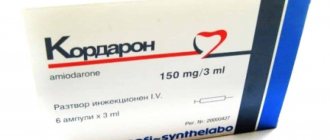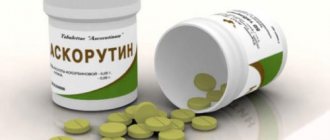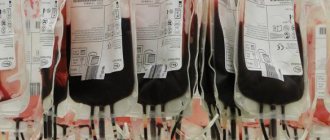7441 02 December
IMPORTANT!
The information in this section cannot be used for self-diagnosis and self-treatment.
In case of pain or other exacerbation of the disease, diagnostic tests should be prescribed only by the attending physician. To make a diagnosis and properly prescribe treatment, you should contact your doctor. We remind you that independent interpretation of the results is unacceptable; the information below is for reference only.
Beta-2-microglobulin (in blood): indications for use, rules for preparing for the test, interpretation of results and normal indicators.
Indications for prescribing the study
Beta-2 microglobulin (Beta-2 microglobulinserum, BMG) is a protein that is found on the surface of almost all cells in the human body.
The study of beta-2-microglobulin in the blood is prescribed for kidney diseases, for patients on dialysis to assess the risk of developing amyloidosis (deposition of pathological proteins in organs and tissues), to identify early signs of kidney rejection after transplantation. Beta-2-microglobulin is often elevated in the blood in cancers such as multiple myeloma (a tumor of the blood cells (lymphocytes) that destroys bones), lymphoma (a tumor that primarily affects the lymph nodes), and leukemia (blood cancer).
What is gamma globulin?
Globulins are heterogeneous in structure and function. Their division into fractions is based on different mobility when separated under the influence of an electric field. Gamma globulins are determined by their lowest mobility. They contain antibodies that have enzymatic activity and perform a protective function: they neutralize the effects of various bacteria, viruses, and protozoa. The most important of them are immunoglobulins (IgG, IgA, IgM, IgE), which provide humoral immunity. The gamma globulin fraction includes alpha agglutinins and beta agglutinins, which determine belonging to a particular blood group, as well as blood coagulation factors and cryoglobulins.
The composition of the fraction may vary depending on the needs of the body. A high content of gamma globulins is observed in many diseases, especially infectious ones, but the total volume of proteins in the plasma remains, as a rule, unchanged, that is, with an increase in gamma globulins, the albumin fraction decreases. The ratio of globulins and albumins in the blood is normally 1:2, the acceptable figure is 1.7:2.2.
Thus, the diagnostic value is not so much the total amount of protein in the blood as the change in the ratio of their fractions.
Preparation for the procedure
- It is preferable to wait 4 hours after your last meal.
- On the eve of the study, you should avoid food overload (do not eat too much!).
- Avoid drinking alcohol on the eve of the test.
- Do not smoke for at least 1 hour before the test.
- Try not to overexert yourself physically and emotionally on the eve of the test.
- When studying the concentration of beta-2-microglobulin in the blood over time, it is recommended to conduct repeated studies under the same conditions (donate blood in the same laboratory).
Complexes with this research
Advanced male anti-aging diagnostics Advanced monitoring of key indicators in men aged 40+ RUB 25,520 Composition
Male hormones Assessment of hormonal levels in men at any age RUB 4,190 Composition
Female hormones. Follicular phase Assessment of the hormonal status of a woman in the follicular phase RUB 3,990 Composition
IN OTHER COMPLEXES
- Anti-aging diagnostics. Hormonal balance RUB 4,490
- Male anti-aging diagnostics RUB 8,840
- Male infertility. Extended examination RUB 21,080
Reference values:
| Age | Men, mg/l | Women, mg/l |
| 1 day – 4.3 weeks. | 1,6 – 4,8 | 1,7 – 4,5 |
| 4.3 weeks – 6 months | 1,4– 3,3 | 1,0 – 3,8 |
| 6 months – 12 months | 0,9 – 3,1 | 1,0 – 2,3 |
| Over 1 year old | 0,9 – 2,0 | 0,9 – 2,0 |
Beta-2-microglobulin is present on almost all cells of the body and is released into the blood, especially by beta lymphocytes (blood cells that provide immunity, recognize foreign structures, and synthesize antibodies).
In the human body, beta-2-microglobulin performs important functions:
- provides the process of antigenic presentation (presentation) of a foreign agent to trigger an immune response;
- participates in cell proliferation (cell reproduction by division);
- involved in the process of apoptosis (controlled physiological self-destruction of cells);
- regulates the production of hormones and cell growth factors.
Beta-2-microglobulin is used in clinical practice as a tumor marker for patients with blood cancer (when blood cells degenerate into tumor cells and cease to perform their functions).
Blood beta-2-microglobulin concentrations are used to determine the severity and spread of multiple myeloma and lymphoma. A higher level of beta-2-microglobulin in the blood corresponds to a more advanced stage of the oncological process.
Studying the concentration of beta-2-microglobulin in the blood over time allows us to draw conclusions about the effectiveness of treatment:
- an increase in beta-2-microglobulin levels may mean that the cancer is spreading and therapy is not effective;
- a decrease in beta-2-microglobulin levels indicates a good prognosis and effective treatment;
- A decrease and subsequent increase in beta-2-microglobulin levels indicates that the cancer has recurred after treatment.
Beta-2-microglobulin is present in most body fluids, most in the blood, less in the cerebrospinal fluid, and trace amounts in the urine.
In adults, the production of this protein is relatively constant. Beta-2-microglobulin passes through the glomeruli of the kidneys (structures that filter the blood), and then returns to the lower parts (in the kidney tubules). When the glomeruli of the kidneys are damaged, they cannot filter beta-2-microglobulin and its levels in the blood increase. The study of beta-2-microglobulin in patients with kidney disease is prescribed for differential diagnosis in order to determine which parts of the kidney are damaged.
In people with kidney disease who are on dialysis (a procedure to artificially cleanse the blood of toxins and harmful substances), beta-2-microglobulin can form abnormal structures that are deposited in joints and tissues (dialysis-associated amyloidosis). Therefore, for patients who have been on dialysis for more than five years, it is recommended to determine the level of beta-2-microglobulin for early detection of amyloidosis.
Archives
Short Wiklad
Th. X. O'Connell, TJ Horita, B. Kasravi Am Fam Physician 2005;71:105-12
Analysis of blood proteins (proteinogram) using additional electrophoresis is often used to identify patients with multiple myeloma and other blood protein pathologies. Many university specialists perform this test until the primary care is over and many people get sick. However, the results of protein tests are important to interpret.
This article provides a detailed overview of the electrophoresography technique, indications, interpretation by proteins and is presented for the purpose of further reporting patients with pathological test results.
Viznachennya
Electrophoresis is a method of separating proteins depending on their physical properties (size, shape and polarity of the electrical charge of the molecule). The blood serum is applied to a special center, and a stream is then passed through it.
Protein warehouse for blood serum
The result of electrophoresis of blood plasma proteins is stored in fractions of two main types of proteins: albumins and globulins. Albumin, the main protein component of blood serum, is synthesized in the liver in normal physiological minds. Globulins become a significantly smaller fraction of the protein content of blood serum. The interpretation of proteinograms is superior to the analysis of protein fractions and their aqueous volume.
Albumin, the highest peak of proteins, migrates closest to the positive electrode. The next five components (globulins), which are consistently located closer and closer to the negative electrode, are designated α1, α2, β1, β2 and γ. Figure 1 shows an image of the distribution of blood serum proteins using electrophoresis in normal conditions.
Rice. 1.
The result of electrophoresis of blood plasma proteins is normal.
Albumin
Albumin becomes the largest protein fraction in the Syrian population. Its rhubarb decreases when the synthesizing function of the liver is impaired and when the loss of protein increases. A low level of albumin is caused by poor nutrition, liver disease, loss of blood (for example, with nephrotic syndrome), hormone therapy, drugs and vaginitis, and before mobility - conditions that are accompanied by a decrease in blood pressure. place of water in blood syringation (for example, dehydration).
Alpha fraction of globulins
The α1-fraction consists of α1-antitrypsin1, thyroid-binding globulin and transcortin2. It increases in case of malignant diseases and acute ignition process (due to acute phase proteins), and decreases in case of α1-antitrypsin deficiency and decreased synthesis of globulins in case of liver diseases. The α2-fraction contains ceruplasmin3, α2-macroglobulin4 and haptoglobulin5, a number of which can grow as acute phase proteins.
Beta fraction of globulins
The β-fraction of globulins contains two peaks: β1 (formed mainly by transferrin) and β2 (β-lipoprotein). Before the β-fraction there are also complement factors, IgA, IgM and IgG inodes.
Gamma fraction of globulins
It is important for clinicians to reach the γ-fraction in order to remove immunoglobulins, so that the proteins can migrate to other fractions under electrophoresis. C-reactive protein is localized between the β- and γ-fractions.
Indications before recognition as proteins
Electrophoresis of serum proteins is, as a matter of course, indicated in case of suspicion of multiple myeloma, in order to determine other indications (Table 1).
Table 1. Indications before the appointment of proteins with additional electrophoresis
|
Although the result of electrophoresis of blood serum proteins is normal, the presence of multiple myeloma, Waldenström's macroglobulinemia, primary amyloidosis or illness associated with them is still suspected, which is considered significant Proteinography was carried out using the immunofixation method, since this method is sensitive for the detection of small monoclonal (M) proteins.
Interpretation of results
In cases of inflammation, acute illness, trauma, necrosis, heart attack, drugs and chemical treatments, the number of so-called “hospital phase proteins” increases in the plasma: fibrinogen, antitrypsin, haptoglobule ina, ceruloplasmin, C-reactive protein, C3-fraction of complement and α1 -acid glycoprotein. Often the level of albumin and transferrin also decreases. Table 2 shows changes in the storage of proteins in the acute phase, characteristic of early illnesses.
Table 2. Sickness and clinical conditions associated with characteristic changes in the proteins of the acute phase in the proteinogram
|
When interpreting the results of electrophoresis of blood serum proteins, it is important to pay attention to the gamma fraction, which mainly consists of antibodies of the IgG class. Although the gamma fraction grows due to a variety of reasons, some illness is caused until a homogeneous gostrophase peak appears in the distribution of gamma globulins (Fig. 2). These so-called “monoclonal gammopathies” are a group of diseases characterized by the proliferation of one clone of plasmatic cells that synthesize homogeneous M-proteins.
Rice. 2.
Pathological result of electrophoresis of blood serum proteins in a patient with multiple myeloma. Return respect to the great gastrophase peak in the gamma fraction.
Differential diagnosis of monoclonal and polyclonal gammopathies
It is important to differentiate monoclonal from polyclonal gammopathies, some monoclonal gammopathies are associated with a malignant or potentially malignant clonal process, and polyclonal ones are also associated with any , as of course, with non-malignant reactive or ignition changes. Table 3 shows the most common etiological causes of polyclonal gammopathy.
Table 3. Differential diagnosis of polyclonal gammopathy
|
M-paraprotein is characterized by the presence on the electrophoresogram of gostrophase, clearly expressed smudge, which consists of one important lancet, and a similar smudge with κ-or λ-light lancet. In polyclonal gammopathy, a wide diffuse discoloration with one or several important and κ- and λ-lances is evident.
After identifying monoclonal gammopathy, using electrophoresis of blood serum proteins, it is possible to differentiate multiple myoma from other agents of this type of gammopathy: Waldenström's macroglobulinemia, solitary plasmacytomas, latent multiple myeloma, essential monoclonal benign gammopathy, plasma cell leukemia, important lancin disease and amyloidosis.
Calcium instead of M-paraprotein can help make a differential diagnosis between multiple myeloma and monoclonal gammopathy of unknown importance. The criterion for diagnosing multiple myeloma is the presence of 10–15% plasmatic cells in the cerebrovascular transplant. Table 4 shows the characteristic differential symptoms of monoclonal gammopathies.
Table 4. Characteristic signs of monoclonal gammopathies (per ED George, R. Sadovsky, 1999)
| Sickness | Characteristic signs |
| Multiple myeloma | The presence of M-paraprotein in the form of a narrow peak in the γ-, β- and α2-fractions. Rhubarb M-paraprotein, as a rule, > 30 g/l. Skeletal disorders are present in 80% of patients (for example, phlebitis, diffuse osteopenia, compression fractures of the spine). To make a diagnosis, it is necessary to detect 10–15% of plasma cells in a bone marrow biopsy. Anemia, pancytopenia, hypercalcemia and low levels may be present. |
| Essential monoclonal benign gammopathy | Rhubarb M-paraprotein < 30 g/l. The presence of plasmacytes in cerebrovascular grafts is < 10%. The prevalence of M-paraprotein in patients, lytic cysts, anemia, hypercalcemia and low levels. |
| Latent multiple myeloma | Rhubarb M-paraprotein > 30 g/l. The presence of plasmacytes in bone marrow biopsy is > 10%. The presence of cysts, anemia, hypercalcemia and low levels in patients with lethal symptoms. |
| Plasmacytocytocyte leukemia | The level of M-paraprotein is low. Detection of >20% plasmacytes in peripheral blood analysis. The presence of a small number of cysts and changes in blood storage. Trapped by the sick of the young age |
| Solitary plasmacytoma | Detection of more than one lesion of swelling without other lesions of cysts, side pathologies and blood serum |
| Waldenström's macroglobulinemia | Detection of M-paraprotein of the IgM class. Detection of increased blood viscosity, enriched cellular tissue in the cerebrospinal fluid with pronounced infiltration by lymphoplasmacytes |
| Illness of important Lancsugs | M-paraprotein is composed of an uneven important lance and the presence of a light lance. |
In some patients with dyscrasia of plasmatic cells, the result of electrophoresis of blood serum proteins may be normal due to the presence of monoclonal immunoglobulin or its presence in the slightest degree. A recent study by Kyle RA (1999) found that the acute phase peak or localized presence of pathological immunoglobulin using electrophoresis can only be detected in 82% of patients with multiple myeloma. Most patients were diagnosed with hypogammaglobulinemia or a normal variant. Therefore, in all patients with suspected dyscrasia of plasma cells, it is recommended to carry out electrophoresis of protein sections.
It also adds a lot of M-paraprotein. Although in patients with multiple myeloma it exceeds 30 g/l, in 1/5 of such patients it is less than 10 g/l. Approximately 10% of patients with multiple myeloma with absent M-peak show hypogammaglobulinemia on electrophoresis. Most of these patients have obvious Bence-Jones proteins (monoclonal κ- or λ-Lance immunoglobulins) in large quantities. Therefore, kolkisny, instead of M-paraprotein, does not allow the multiple myeloma to turn off.
If a patient with a daily response to M-paraprotein, after electrophoresis of blood serum proteins based on the clinic, multiple myeloma is suspected, then electrophoresis of blood serum proteins is performed.
Obstruction of patients with pathological results of proteinograms
Monoclonal gammopathy is present in 8% of healthy geriatric patients. For all patients with monoclonal gammopathy, further investigation should be carried out to identify its etiology. Patients with essential monoclonal benign gammopathy will require close clinical monitoring, although approximately 1% of them will develop multiple myeloma or other malignant monoclonal gammopathy. Figure 3 shows the algorithm for dispensary monitoring of patients with monoclonal gammopathy.
Rice. 3.
Scheme of dispensary monitoring for patients with monoclonal gammopathy (per RA Kyle, 1999). Notes. EBSC - electrophoresis of blood serum proteins
1 Nephelometry is based on the quantitative value of immunoglobulins.
2 Additional cut is collected for quilting using electrophoresis and immunofixation.
3 Brush clasp includes visual radiography of the shoulder and wrist cuffs in one projection.
4 These tests are indicated in cases of suspicion of Waldenström's macroglobulinemia or other lymphoproliferative processes.
5 If pathological changes are detected within the hour of repeated EBSC, the patient should be referred to a hematologist-oncologist.
Once the concentration of M-paraprotein reaches 15–25 g/l, then perform nephelometry for the quantitative determination of obvious immunoglobulins and collect a sample for analysis using electrophoresis and immunofixation. If the results of these tests will be normal, electrophoresis of blood serum proteins will be repeated on the skin for 3–6 months, if both results will be normal, electrophoresis of blood serum proteins will be repeated on the skin. privately If pathological changes are detected during the hour of repeated fasting or in dynamics, such a sick trace should be taken to a hematologist-oncologist.
Since, instead of M-paraprotein, 25 g/l is important, follow the brushing of the wrists (zocrem, humerus and sternocles) for the presence of metastases, and also determine the level of β2-microglobulin, C-reactive protein and siphon I am looking for further investigation by electrophoresis and immunofixation. If Waldenström's macroglobulinemia or other lymphoproliferative disease is suspected, follow up with computed tomography of the cervix, aspiration and biopsy of the cerebrospinal fluid. If the results of any of the named tests are pathological, such illness should be referred to a hematologist-oncologist. Figure 3 shows a diagram of dispensary monitoring of patients with normal test results.
Prepared by Bogdan Boris
1 Inhibits the activity of trypsin and other proteolytic enzymes. Deficiency of this protein is associated with the development of emphysema. (Note switch)
2 It specifically binds and transports non-conjugated, biologically active cortisol in the plasma. (Note switch)
3 The function has not been sufficiently studied, obviously, it takes part in transporting and maintaining the balance of media in tissues, has ferrooxidase activity, oxidizes additional insaturation of semiconductors. The level of this protein decreases during Wilson-Konovalov's illness. (Note switch)
4 Inhibits a lot of proteolytic enzymes. (Note switch)
5 Irretrievably associated with free hemoglobin, as a result of which it is partially removed from the liver, avoiding the loss of free hemoglobin from the section. The level of this protein decreases with hemolysis, and increases with conditions that are accompanied by significant tissue damage and necrosis. (Note switch)
6 Rheumatoid illness, which is characterized by clinical symptoms of systemic worm-eaten disease, scleroderma, rheumatoid arthritis and myositis (Raynaud's syndrome, skin tag, arthritis/arthralgia, impaired mobility stravhohod, myositis and hypertension in the coli) and the presence of antibodies against U1-ribonucleoprotein. (Note switch)
Reasons for increased levels of beta-2-microglobulin in the blood:
- inflammatory process in the body;
- autoimmune disorders (including systemic lupus erythematosus, Sjogren's syndrome, rheumatoid arthritis), when the immune system mistakenly attacks its own cells;
- blood cancer - multiple myeloma, B-cell chronic lymphocytic leukemia, non-Hodgkin's lymphoma, Hodgkin's disease;
- viral infections (HIV, cytomegalovirus infection, infectious mononucleosis, etc.);
- renal failure;
- kidney transplant rejection;
- in patients on hemodialysis.
Reasons for the downgrade
A decrease in the content of gamma-glubulins in the blood plasma, or hypogammaglobulinemia, can be primary or secondary. The primary ones include:
- physiological – observed in small children 3-5 months old and considered normal;
- congenital;
- idiopathic – occurring for unknown reasons.
Secondary hypogammaglobulinemia develops against the background of diseases that deplete the immune system. Gamma globulin decreases in the following cases:
- with nephrotic syndrome (nephrosis);
- in case of impaired synthesis of immunoglobulins;
- during therapy with cytostatic drugs;
- for long-term infectious diseases;
- in children after removal of the spleen;
- as a result of exposure to radiation.
Reasons for the decrease in beta-2-microglobulin in the blood over time:
- effective cancer treatment.
Sources:
- Drueke TB, Massy ZA. Beta2-microglobulin. Semin Dial 2009; 22: 378–380.
- ChanghoonYoo, Dok Hyun Yoon, Cheolwon Suh.Serum beta-2 microglobulin in malignant lymphomas: an old but powerful prognostic factor. Blood Res. – 2014.
- Burtis CA, Bruns DE. Tietz Fundamentals of Clinical Chemistry and Molecular Diagnostics, seventh edition, 2015; 306 p.
- Corlin D, Heegaard N (2012) β2-Microglobulin Amyloidosis. In: Harris J (eds) Protein Aggregation and Fibrillogenesis in Cerebral and Systemic Amyloid Disease. Subcellular Biochemistry, vol 65. Springer, Dordrecht.
- S. Vincent Rajkumar. Myeloma Today: Disease Definitions and Treatment Advances, Am J Hematol. 2021 Jan; 91(1): 90–100.







